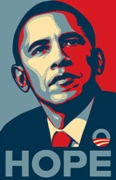IP Colloquium Tackles Fairey v. AP
![]() Doug Lichtman at UCLA is producing a fantastic series of monthly podcasts on IP issues, called the Intellectual Property Colloquium. This month’s episode is on fair use in the Shepard Fairey case, and features a terrific line-up of guests: Mark Lemley, attorney for Fairey; Dale Cendali, attorney for AP; and Ken Richieri, General Counsel at the New York Times, who adds the view of someone on both sides of the issue. Doug asks some pretty good questions, particularly about the notoriously circular fourth fair use factor (the effect on the potential market). It’s worth a listen, and you can also use it for CLE credit in six states, “and any state that accepts any of those through reciprocity,” which I believe includes Wisconsin (do not rely on me for this).
Doug Lichtman at UCLA is producing a fantastic series of monthly podcasts on IP issues, called the Intellectual Property Colloquium. This month’s episode is on fair use in the Shepard Fairey case, and features a terrific line-up of guests: Mark Lemley, attorney for Fairey; Dale Cendali, attorney for AP; and Ken Richieri, General Counsel at the New York Times, who adds the view of someone on both sides of the issue. Doug asks some pretty good questions, particularly about the notoriously circular fourth fair use factor (the effect on the potential market). It’s worth a listen, and you can also use it for CLE credit in six states, “and any state that accepts any of those through reciprocity,” which I believe includes Wisconsin (do not rely on me for this).


 (This is the 7th in a series of posts on Fairey v. Associated Press. See below for other posts in the series.)
(This is the 7th in a series of posts on Fairey v. Associated Press. See below for other posts in the series.)